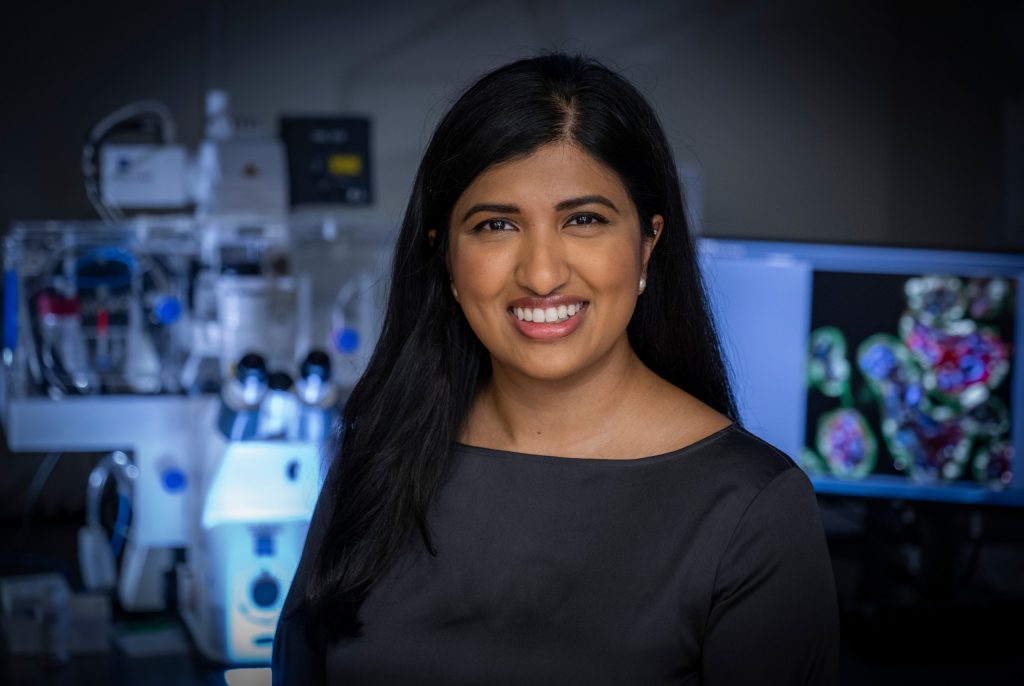
When pregnancy occurs, an early critical step is the formation of the placenta to connect the mother to the fetus, providing oxygen and nutrients and eliminating waste.
Fourth-year Virginia Tech Carilion School of Medicine student Anisha Chada took a closer look at the newly formed organ that is critical to the development of the fetus and for a successful birth to see how it may be impacted by a condition called preeclampsia.
According to the Preeclampsia Foundation, the condition is a leading cause of maternal and infant illness and death in the United States, occurring in about 5 to 8 percent of pregnancies. Despite its prevalence, the cause remains largely unknown, which made the condition compelling for Chada to explore.
“Preeclampsia is diagnosed after 20 weeks of pregnancy when a mother has hypertension – high blood pressure – that develops during pregnancy. Preeclampsia can increase risk of preterm birth and maternal complications, such as seizures and end-organ damage,” Chada said. “I was interested in looking at the placenta because vascular abnormalities in the placenta are thought to be the reason behind, or central to, the development of preeclampsia.”
Chada joined the lab of vascular biologist John Chappell in the Fralin Biomedical Research Institute at VTC. His lab explores early blood vasculature development. Chappell shared his lab’s work with Chada’s class during their first year and offered up ideas for topics to investigate and mentioned the placenta.
“I just threw it out there and said if someone is brave enough to join the lab and work on this, it could be interesting. No one else in the lab is exploring it. It would be getting something off the ground from scratch,” Chappell said. “Could we affect clinical management of preeclampsia patients? If we knew more about how the vessels remodel or don’t remodel appropriately, perhaps we could detect preeclampsia sooner or resolve it.”
Chada and fellow Class of 2020 student Malek Bouzaher jumped at the challenge, working on related projects in Chappell’s lab over the past three years.
One of the biggest challenges was that in order to study placentas, Chada and Bouzaher had to get access to placenta tissue samples. They worked with Allison Durica, assistant professor in the Department of Obstetrics and Gynecology, and resident physicians Megan Lord and Hoa Nguyen to connect with labor and delivery staff at Carilion Roanoke Memorial Hospital to alert them when patients may be willing to consent to donate their placenta post-delivery.
Chada and Bouzaher were able to collect 50 samples. Sometimes that meant a trip to the hospital in the middle of the night. “You can’t really time deliveries or when placentas would be ready to collect, especially since preeclampsia can lead to emergent deliveries,” Chada said. “Sometimes I would go collect a sample at 4 in the morning, take it to the lab to process, and back to the hospital for my clerkship rotation at 5. I was passionate about the project and so thankful to the patients for donating this tissue to us. Everyone put in a lot of effort to make it successful.”
Once the samples were in the lab, Chada would stain the tissue and use a laser-scanning confocal microscope to visualize the vascular components. “The placenta is really the lifeblood of the fetus while it’s growing. If something is happening to mom, like hypertension, the baby will be impacted,” Chada said.
She found the placenta had an unexpected response. “We know in preeclampsia, the mother has very-high-resistance blood vessels – that’s what causes her to develop hypertension. What we found is the placenta may compensate for this by decreasing the amount of muscle and collagen around its vessels,” Chada said. “This could demonstrate a mechanism by which the placenta ensures fetal support in preeclampsia by allowing increased oxygen flow across vessels. This is actually an opposite response to what we see in other parts of the body, which I think further highlights how unique this organ is.”
Every student at the Virginia Tech Carilion School of Medicine is required to complete a research project that spans the curriculum in order to graduate. That requirement was a draw for Chada who did research as an undergraduate.
“I truly felt like a leader on this project and that my opinions not only mattered, but were paramount to the success of the project,” Chada said. “Dr. Chappell is an amazing mentor and wants you to take ownership. I really felt like I was allowed to run with my ideas and I feel quite capable of doing a project of this caliber again in the future.”
“It’s great having medical students in the lab as clinicians in training,” Chappell said. “They go to classes and see patients and bring that knowledge back to our lab to integrate with the questions we are asking.”
Chada is one of eight students in the Class of 2020 who received Letters of Distinction for their research project.


